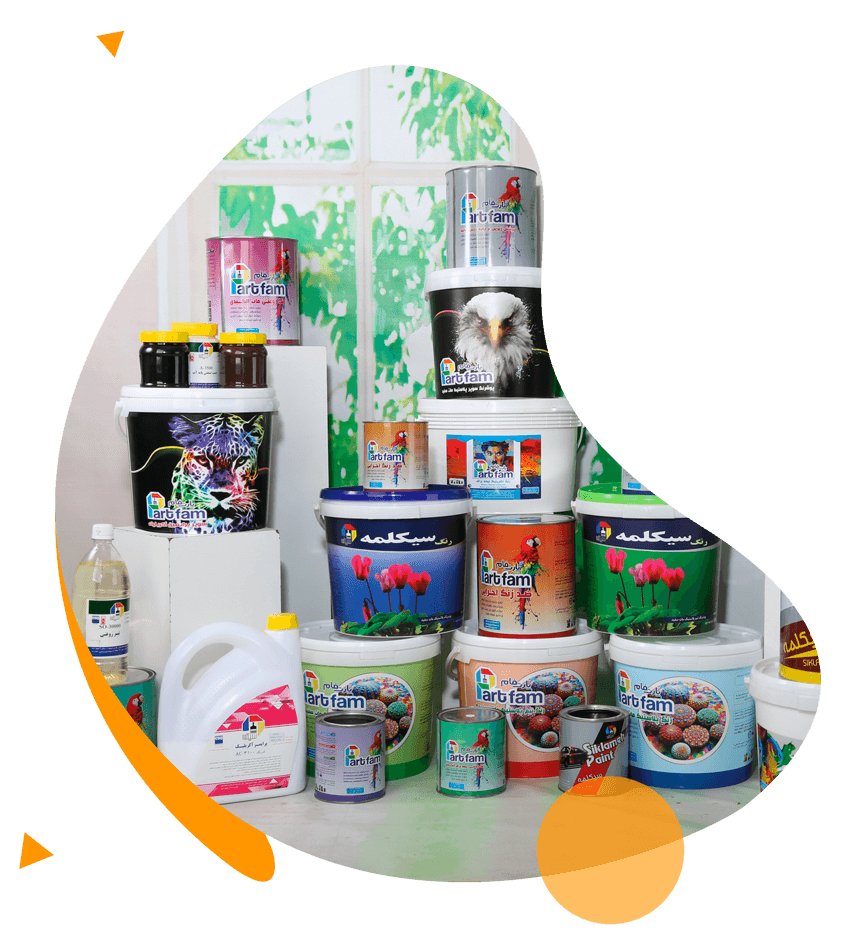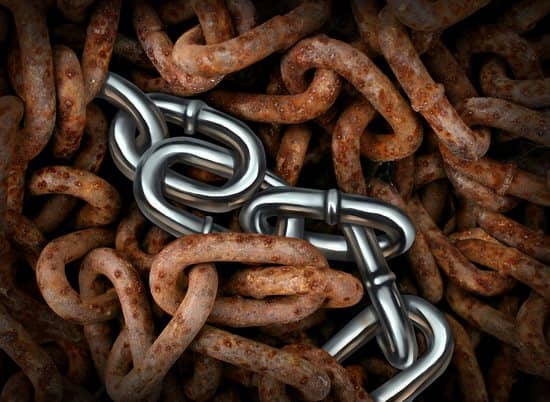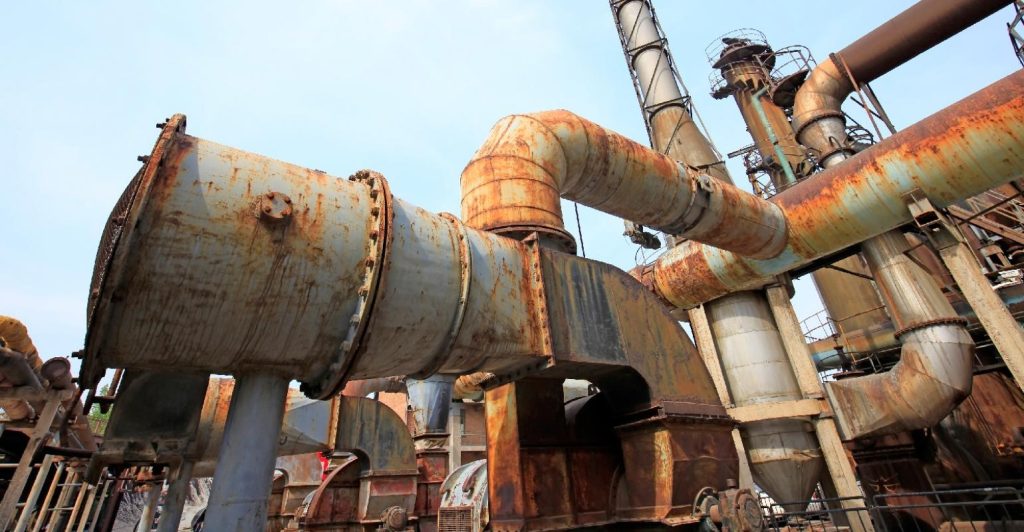Corrosion is defined as an irreversible damage to a metal surface that lead to the conversion of a pure metal into more chemically stable forms like sulphides, oxides, hydroxides, etc. Here, chemical and electrochemical reactions occur on the metal’s surface in a corrosive environment, which can be solid, liquid, or gas. It is with this corrosive medium that corrosion can be classified as dry or wet. Metallic corrosion is the inverse of extraction of metals from their ores. It is a result of materials’ inclination to transition into their states of least energy. Most metals occur in nature in ore forms. So to extract metals from ores, energy is needed. But during metals’ life cycle, they will tend to be oxidized, going back to their original states. The greater the energy needed to extract metals, the greater is their tendencies to corrode. In general, metallic corrosion involves an electrochemical process. The process typically includes an electrolyte that enables the transfer of ions (cations and anions) within and give rise to anodic and cathodic reactions. When two different metals are present in such an electrolyte, the less noble metal becomes the anode and corrodes, while the more noble metal becomes the cathode and is protected. The flow of electrons occurs from the anodic to the cathodic metal. Among the two metals, the one with a higher reduction potential, or higher position in the electrochemical series, is more susceptible to corrosion. Moreover, metallic corrosion occurs in various forms depending on the morphology of the metal damage. According to Singh, corrosion can take the form of a general surface attack, gradually diminishing the metal’s thickness. Alternatively, it may occur as isolated corrosion in specific areas or along vulnerable lines such as grain boundaries, influenced by variations in resistance to a corrosive environment. The diverse nature of metallic corrosion underscores the susceptibility of metals to various mechanisms and factors leading to corrosion.
Major factors contributing to metallic corrosion include metal purity, characteristics of the surface film, properties of corrosive products, temperature, air humidity, and pH levels. Understanding these factors is crucial for a comprehensive examination of the corrosion process in metals [1].
Purity of the Metal
Corrosion rates typically rise with the increased addition of impurities, as these impurities create small electrochemical cells where the anodic part undergoes corrosion. For instance, zinc with impurities such as iron (Fe) or lead (Pb) experiences a faster rate of corrosion [1].
Nature of Corrosive Product
Corrosion advances more rapidly when the formed product is soluble in the corrosive medium. Additionally, if the corrosive product is volatile, it evaporates upon formation, exposing the metal surface for further attack and exacerbating the corrosion process [1].
Temperature
Corrosion accelerates with higher temperatures, with the rate expected to nearly double for every 100-degreeincrease. The temperature-related increase in corrosion is typically depicted by an exponential curve, but various cases show a more complex relationship, as temperature changes can also alter the impact of other factors [2].
Humidity of the Air
Relative humidity significantly influences the rate of corrosion, rising sharply above a specific point known as the critical humidity. Beyond this threshold, the corrosion rate experiences a notable increase. The heightened corrosion with increased humidity is attributed to the oxide film’s tendency to absorb moisture, leading to additional electrochemical corrosion. Moreover, atmospheric moisture provides the necessary water for the electrolyte, essential for the formation of an electrochemical cell [1].
PH
The pH level is a crucial determinant of the corrosion rate, with lower PH values associated with higher corrosion rates. Acidic environments, characterized by a PH less than 7, exhibit greater corrosiveness compared to alkaline or neutral media. For noble metals such as gold and platinum, the corrosion rate is notably low and exhibits minimal dependence on the solution’s PH. Noble metals, while generally resistant to corrosion, are often not used for common purposes due to their high cost. For the other metals such as aluminum, zinc and lead, there is a significant increase in the corrosion rate in both acidic and alkaline mediums compared to neutral solutions. This is explained by the solubility of the oxides of these metals in both acid and alkaline environments [2].
TYPES OF CORROSION
There are diverse types of metallic corrosion, including general corrosion, as well as more specific forms such as localized corrosion (pitting and crevice), stress corrosion, cracking, intergranular corrosion, galvanic corrosion, erosion corrosion, waterline, and biological corrosion.
General Corrosion
This type of corrosion is known as uniform corrosion, characterized by a relatively uniform deterioration of the metal surface. It progresses at the same rate across the entire barren area. Oxygen serves as a primary catalyst for this corrosion, and common materials susceptible to general corrosion include cast iron and steel. Exposure to a moist atmosphere causes them to develop a rust-like appearance [1].
Localized Corrosion
This corrosion type occurs when specific small areas on a metal surface corrode more easily than the overall surface in a corrosive environment. These localized areas are partially corroded at a faster rate due to the presence of the corrosive medium. The region with limited oxygen supply acts as the anode, while the area with a full supply acts as the cathode. It further manifests in two types, namely, pitting and crevice corrosion.
- Pitting Corrosion
Pitting corrosion, a significant form of localized corrosion, starts in a small area on a material and gradually expands, forming deeper pits on the surface which may be difficult to detect. Pits or holes, which can be either hemispherical or cup-shaped, are created in this process, with the area covered by impurity or water serving as the anode, while the uncovered are acts as the cathode. The dissolution of the metal is thought to be governed by an electrochemical mechanism in this type of corrosion. Stainless steel, aluminum, and iron are highly prone to pitting corrosion, making it a particularly dangerous form of corrosion. Despite being generally corrosion-resistant, having chromium and nickel, materials like stainless steels can still experience pitting corrosion due to localized attacks on their protective oxide films [1].
- Crevice Corrosion
Crevice corrosion is characterized by corrosion within restricted spaces that occurs in stagnant, less oxygenated areas, like crevices between metal surfaces or beneath deposits (sand, dirt, mud, etc.). The joint area within the crevices has a lower oxygen content compared to the outer area, causing it to act as the anode, while the outer area serves as the cathode. Crevice corrosion poses a significant practical challenge, particularly in marine applications. Crevice corrosion also primarily impacts stainless steels, and the presence of chloride adds challenges associated with addressing this type of corrosion [3].
Stress Corrosion Cracking
Stress corrosion cracking (SCC) is a type of corrosion triggered by applied stress on a material, initially present in an inert environment, leading to the development of cracks in a corrosive environment. This form of corrosion can be accelerated by either residual internal stresses within the metal or externally applied stress. SCC predominantly occurs at high temperatures and is more prevalent in alloys than in metals. Three essential factors for SCC to take place are: (i) the presence of a susceptible material, (ii) exposure to a corrosive environment, and (iii) the presence of tensile stresses [1].
Intergranular Corrosion
Intergranular corrosion, also known as intergranular attack, occurs when the edges or margins of a metal surface are more vulnerable to a corrosive environment than the core. In this case, corrosion primarily occurs in a narrow zone at and near the grain boundaries of a metal alloy, while minimal or no corrosion occurs within the grains themselves. Further, this type of corrosion can conceal the material’s corrosion resistance under various conditions and is often assessed through an IGA Test. It is also not influenced by the addition of impurities such as carbon, nitrogen, oxygen, manganese, and sulfur. However, the addition of silicon and phosphorus does impact the corrosion in this context [1, 4].
Galvanic Corrosion
According to electrochemistry, galvanic corrosion arises on discrete portions of a metallic surface due to the presence of an anodic portion and a cathodic portion. Galvanic corrosion occurs in two dissimilar metals, when one metal, in the presence of a suitable electrolyte, preferentially corrodes over another metal with which it has electrical contact. In this process, the metal acting as the cathode, the less reactive, is protected, while the metal serving as the anode, more reactive, undergoes corrosion [1].
Erosion
Erosion occurs when the metal surface undergoes corrosion due to relative movement between the metal and a corrosive fluid. In cases where the fluid contains solid particles harder than the metal surface, erosion results from the combined action of corrosion and abrasion. Conversely, when the fluid contains softer particles than the metal, erosion occurs through corrosion and attrition. The rate of relative flow provides insights into abrasion, while the mechanism of chipping and cracking determines the cause of erosion. Erosion occurs due to the simultaneous formation and removal of scale from the surface of the material [5].
Waterline Corrosion
Waterline corrosion occurs in metallic tanks when they are partially filled with water. The area below the water surface, which is poorly oxygenated, acts as the anode, while the area above the water line, with a significant amount of oxygen, acts as the cathode. As a result, the area just below the water level undergoes corrosion, while the area above the water level remains protected from this specific type of corrosion. This type of corrosion is commonly encountered by marine engineers. The impact of this corrosion can be mitigated to some extent by using anti-fouling paints [1].
Biological Corrosion
Biological corrosion is influenced by the activities of living organisms, including microorganisms (e.g., bacteria) and macroorganisms (e.g., algae, fungi, barnacles). Other terms used for this type include, microbial, microbiologically influenced corrosion (MIC) or microbial induced corrosion (MIC). Thriving in diverse pH, temperature, and pressure conditions, this type of corrosion manifests in various environments. The involvement of living organisms in metabolic reactions directly impacts anodic and cathodic reactions, disrupts protective films, and creates corrosive conditions or deposits, making biological corrosion distinct due to the role of organisms in facilitating or accelerating specific corrosion types [1].
Prevention of Corrosion
Various methods to prevent corrosion have already been reported in the literature. Some of these methods include pre-treatment, proper design and material selection, sacrificial protection, cathodic protection, barrier protection, electroplating, zinc galvanizing, and use of laser technology. Each method aims to mitigate or resist the corrosive effects on metal surfaces in different ways.
Pre-treatment of Metals
Prior to implementing any protective measures, it is essential to thoroughly clean the metal surface. Degreasing, commonly accomplished using a volatile organic solvent like trichloroethylene, effectively dissolves oily and greasy surface films. Additionally, acid pickling serves as an alternative method to remove scale, complementing mechanical cleaning. Adequate preparation of the metal surface, including the removal of oils and grease, is necessary before applying any coating and can be achieved through washing with an alkali solution [6].
Proper Design
In designing materials to minimize corrosion, key principles include ensuring that when two different metals make contact, the metal designated as the anode should have a larger area, while the other metal should have a smaller area. Additionally, if dissimilar metals are in contact, they should be positioned as close as possible in the electrochemical series. When direct contact is unavoidable, the use of insulating materials is recommended to prevent direct metal-to-metal electrical contact. Sharp corners should be avoided to discourage solid accumulation, and caution is advised against painting or coating metals to prevent rapid localized corrosion in the event of coating breaks [7].
Right Material Selection
The selection of the right material must be based on their intended use in the working environment to ensure optimal resistance. This is instigated by considering properties such as tensile strength, corrosion resistance, and cost-effectiveness. The process includes prior selection based on experience and safety, followed by laboratory testing to re-evaluate the material under specific conditions, and an analysis of the results to assess factors like impurities, temperature, and pressure [7].
Sacrificial Method
Sacrificial protection involves safeguarding a metal by applying a layer of another metal that is more active or electropositive, providing protection through the sacrificial corrosion of the outer layer rather than the primary metal. In sacrificial protection, the more active metal surface loses electrons, entering an ionic state by releasing electrons. Over time, the more active metal gets depleted, but only as long as it is present. For example, coating iron (Fe) with zinc (Zn) in galvanization serves as sacrificial protection, where Zn, being more electropositive, acts as the anode and corrodes, protecting the underlying Fe until the zinc layer is exhausted [1].
Cathodic Protection
In the process of sacrificial protection, a material, say iron, which is to be protected is connected to a more active metal, designating the iron as the cathode and the protective metal as the anode. The anode, being more active, undergoes oxidation and gradually depletes into ions through the loss of electrons. Cathodic protection is done in two ways, namely, sacrificial anode and impressed current methods. The sacrificial anode method involves sacrificial corrosion of the anode to protect the material, which is why it is referred to as the sacrificial anode method. The commonly used metals for anodes are magnesium, zinc, and aluminum, having qualities such as efficient current yield in both theory and practice and sustained current without diminishing over time, avoiding issues like passive film formation. On the other hand, impressed current method employs non-corroding inert anodes to generate a current flow through an external source, and the degree of protection is determined by the applied potential. To facilitate protection, the potential should be sufficiently reduced to eliminate the anodic reaction of metal dissolution, reaching a value equal to or below the equilibrium potential of its oxidation reaction. Specifically, in this method, an insulated wire internally connects the anode and the material to be protected, establishing a current path through the electrolyte. Unlike the galvanic system, which relies on the difference in oxidation potential, the impressed current method uses an external power supply to drive the current flow [1].
Barrier Protection
Coating the metal surface is a protective measure against corrosion, and many of these coatings act as barriers between the metallic surface and the corrosive environment. This method is referred to as barrier protection. Coatings can be metallic or nonmetallic, and their effectiveness are significantly influenced by the preparation of the surface, emphasizing the importance of thorough cleaning and preparation processes to achieve adherent and uniform coatings. Coating is one of the simplest methods to prevent corrosion by placing a suitable barrier between the metal surface and the atmosphere, shielding it from the action of air, water, and carbon dioxide. This protection can be achieved by coating the metal surface with paints, oils, or grease, using non-corroding metals, or applying certain chemicals [1, 8].
Electroplating
Electroplating is a method of coating one metal over another by passing an electrical current through a solution. It serves various purposes, including decoration, enhancing appearance, and providing protection. For instance, chromium plating is employed to coat vehicle wheel rims and gas burners for corrosion resistance, while nickel plating is used for both decorative purposes and various machinery parts. The electroplating process involves a specific procedure [1].
Zinc Galvanizing by Hot Dipping Method
The process involves immersing cleaned steel in molten zinc at a temperature of approximately 445-450°C, hence it is termed the hot-dipping method. This method is commonly used for applying a zinc coating to steel surfaces. Compared to electroplating, the hot-dipping method is often preferred because it offers superior corrosion protection to the metal. The coating applied through hot dipping is more effective in preventing corrosion [9].
Laser Technology
The use of laser technology can also be used to protect metals from corrosion. For instance, laser shock peening (LSP), a recent surface treatment, aims to minimize metal corrosion by inducing deep residual mechanical stress through shock waves generated by high-energy density laser pulses onto the target surface. The growing use of lasers is attributed to their high productivity, automation capabilities, non-contact processing, and elimination of finishing operations, reduced processing costs, improved product quality, maximum material utilization, and minimal heat-affected zone (HAZ) [10].
REFERENCES
- Corrosion of Metals: Factors, Types and Prevention Strategies. Journal of Chemical Health Risk. JCHR (2024) 14(1), 79-87 | ISSN: 2251-6727.
- Yadla, S. V., Sridevi, V., Lakshmi, M. V. V. C., &Kumari, S. K. (2012). A review on corrosion of metals and protection. International Journal of Engineering Science & Advanced Technology, 2(3), 637-644.
- Laranjo, R. D., & Anacleto, N. M. (2017). Production of Fe-Cr-Ni-Mn alloy by direct smelting of mixed low-grade chromite, nickel laterite and manganese ores with low-grade coal as reductant. International Journal of Metallurgical & Materials Science and Engineering (IJMMSE), 7(1), 1-12.
- Tan, Y. J., Bailey, S., & Kinsella, B. (2001).Mapping non-uniform corrosion using the wire beam electrode method. II. Crevice corrosion and crevice corrosion exemption. Corrosion science, 43(10), 1919-1929.
- Tan, Y. (2011). Experimental methods designed for measuring corrosion in highly resistive and inhomogeneous media. Corrosion science, 53(4), 1145-1155.
- Zhang, W., & Frankel, G. S. (2003). Transitions between pitting and intergranular corrosion inAA2024. Electrochemical Acta, 48(9), 1193-1210.
- Yape, E. O. (2014). Fe-Ni-Cr crude alloy production from direct smelting of chromite and laterite ores. Journal of Medical and BioengineeringVol, 3(4).
- Kumar, R., Kumar, R., & Kumar, S. (2018b). Erosion corrosion study of HVOF sprayed thermal sprayed coating on boiler tubes: a review. IJSMS, 1(3), 1-6.
- Kumar, R., Singh, R., & Kumar, S. (2018c). Erosion and hot corrosion phenomena in thermal power plant and their preventive methods: a study. Asian Journal of Mechanical Engineering, 7(1), 38-45.
- Jones, F. R., & Foreman, J. P. (2015). The response of aerospace composites to temperature and humidity. In Polymer composites in the aerospace industry (pp. 335-369). Woodhead Publishing.








